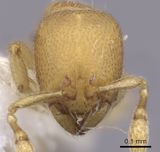Key to Carebara escherichi species complex workers
This worker key is based on: Fernández, F. 2004a. The American species of the myrmicine ant genus Carebara Westwood (Hymentoptera: Formicidae). Caldasia. 26(1):191-238.
As in other myrmicine ants, tiny size is associated with morphological monotony; consequently, accurate separation of Carebara minor workers is challenging and requires careful scrutiny of fine characters at more than 80 magnifications. Future discovery of nests and complete samples of all phases may result in changes in the number of recognized species, which may well be lower than that proposed here. Unfortunately many Carebara minor workers collected alone cannot be identified with certainty.
You may also be interested in
1
- Dorsum of head densely sculptured with shallow foveolated punctures whose diameters are greater than the spaces separating them . . . . . 2
- Dorsum of head densely sculptured with very small, shallow foveolate punctures, broadly separated betwen them . . . . . 6
2
return to couplet #1
- Body totally devoid of standing hairs, appresed pubescence very scarce; Brazil . . . . . Carebara nuda
- Body with few to abundant standing hairs; appresed pubescence moderate to heavy . . . . . 3
3
return to couplet #2
- Head with more than 10 standing hairs . . . . . 4
- Head with less than 10 standing hairs: very few or none . . . . . 5
4
return to couplet #3
- Promesonotum with about 15 standing hairs; legs without standing hairs; Brazil . . . . . Carebara brasiliana
- Promesonotum with more than 20 standing hairs; mid and hind tibia each with about 2-8 standing hairs; Brazil . . . . . Carebara pilosa
5
return to couplet #3
- First tergum of gaster with several standing hairs; mesosoma narrow dorsoventrally, promesonotum flat in dorsal view, propodeal lobes evenly curved; Colombia . . . . . Carebara paya
- First tergum of gaster without standing hairs; mesosoma not as above; Perú . . . . . Carebara inca
6
return to couplet #1
- Promesonotum devoid of standing hairs; Brazil . . . . . Carebara majeri
- Promesonotum with at least 2-4 standing hairs . . . . . 7
7
return to couplet #6
- In dorsal view, promesonotum throughout or partially with fine longitudinal striation . . . . . 9
- In dorsal view, promesonotum with dense reticulation, never striated . . . . . 8
8
return to couplet #7
- In lateral view the propodeum angulated; head dorsum with four standing hairs; legs with about four standing hairs each; Colombia and Ecuador . . . . . Carebara angulata
- In lateral view the propodeum rounded; head dorsum with two standing hairs; legs without standing hairs; Colombia . . . . . Carebara audita
9
return to couplet #7
- Promesonotum throughout with longitudinal striation . . . . . 10
- Most of promesonotum with longitudinal striation (Colombia) . . . . . 11
10
return to couplet #9
- Standing hairs: none in head dorsum, four in promesonotum, none in propodeum, two in first tergum gaster (Colombia, Trinidad, Perú, Brazil) . . . . . Carebara arabara
- Standing hairs: two in head dorsum, six in promesonotum, two in propodeum, two in first tergum gaster (Western Colombia) . . . . . Carebara reina
11
return to couplet #9
- Mid and hind tibiae without standing hairs . . . . . Carebara semistriata
- Mid and hind tibiae with standing hairs . . . . . Carebara kofana













